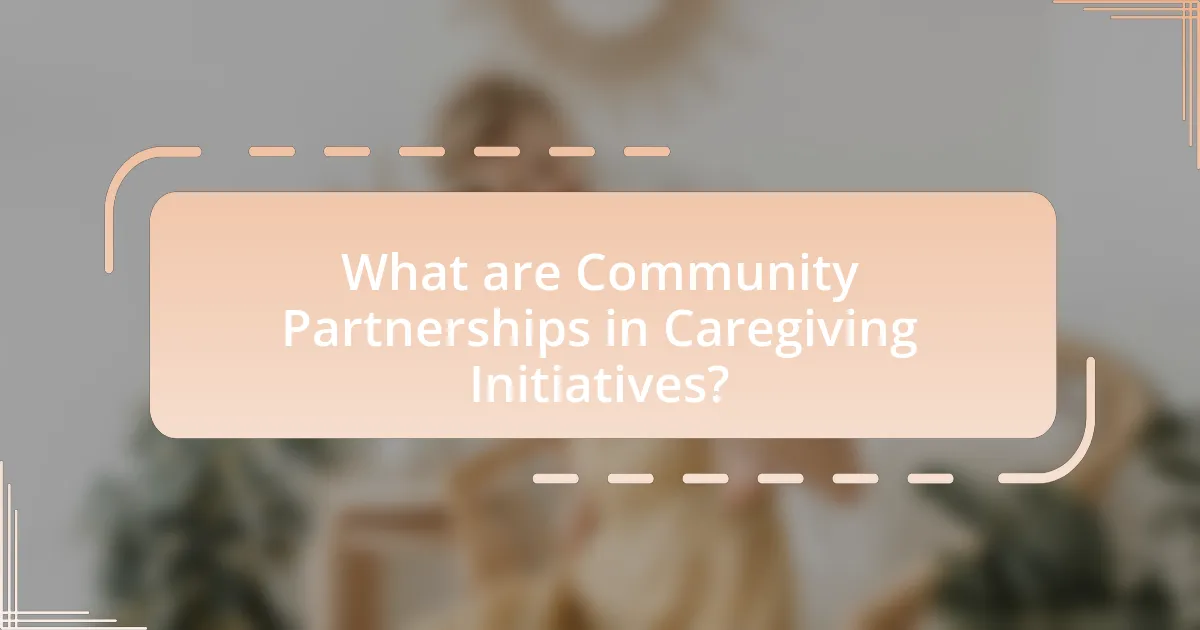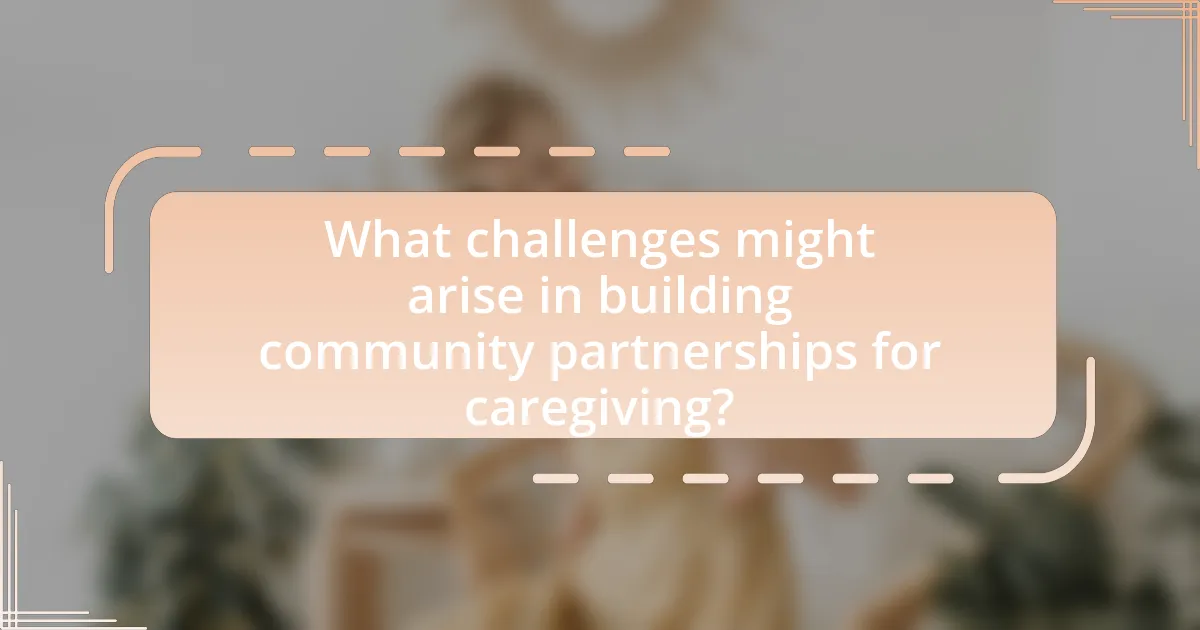Community partnerships in caregiving initiatives are collaborative relationships among healthcare providers, community organizations, and families designed to enhance support for caregivers. These partnerships improve access to resources, facilitate service delivery, and address the diverse needs of caregivers, ultimately leading to better outcomes for both caregivers and care recipients. The article explores how local organizations play a crucial role in these partnerships, the benefits caregivers gain from community support, and strategies for building and maintaining effective collaborations. It also discusses the challenges faced in establishing partnerships and the long-term benefits that arise from sustained community engagement in caregiving initiatives.

What are Community Partnerships in Caregiving Initiatives?
Community partnerships in caregiving initiatives are collaborative relationships between various stakeholders, including healthcare providers, community organizations, and families, aimed at enhancing support for caregivers. These partnerships facilitate resource sharing, improve access to services, and foster a network of support that addresses the diverse needs of caregivers. For instance, a study by the AARP found that community-based programs that engage local organizations can significantly improve caregiver well-being by providing education, respite care, and emotional support.
How do community partnerships enhance caregiving initiatives?
Community partnerships enhance caregiving initiatives by providing resources, support, and collaborative networks that improve service delivery. These partnerships facilitate access to a wider range of services, such as healthcare, transportation, and social support, which are essential for effective caregiving. For instance, a study by the National Alliance for Caregiving found that communities with strong partnerships reported higher caregiver satisfaction and better outcomes for care recipients. By pooling resources and expertise, community partnerships can also foster innovative solutions to common caregiving challenges, ultimately leading to more comprehensive and effective care.
What roles do local organizations play in these partnerships?
Local organizations serve as essential facilitators in partnerships aimed at supporting caregiving initiatives. They provide resources, local knowledge, and community connections that enhance the effectiveness of these partnerships. For instance, local organizations often identify specific community needs and mobilize volunteers, which can lead to tailored support services for caregivers. Additionally, they may offer training programs and workshops that equip caregivers with necessary skills and information, thereby improving the overall quality of care provided. Research indicates that partnerships involving local organizations can increase community engagement and resource sharing, ultimately leading to more sustainable caregiving solutions.
How can community partnerships address specific caregiving challenges?
Community partnerships can effectively address specific caregiving challenges by leveraging shared resources, expertise, and support networks. For instance, local organizations can collaborate to provide training programs for caregivers, enhancing their skills and knowledge, which directly improves the quality of care provided. Research indicates that communities with strong partnerships report higher caregiver satisfaction and reduced burnout, as evidenced by a study published in the Journal of Community Health, which found that 70% of caregivers in partnered communities felt more supported. Additionally, these partnerships can facilitate access to respite care services, allowing caregivers to take necessary breaks, thereby preventing caregiver fatigue and improving overall well-being.
Why are community partnerships essential for effective caregiving?
Community partnerships are essential for effective caregiving because they enhance resource sharing, improve service delivery, and foster a supportive network for caregivers and care recipients. Collaborative efforts among local organizations, healthcare providers, and community members lead to a more comprehensive approach to caregiving, addressing diverse needs and challenges. For instance, studies show that communities with strong partnerships can reduce caregiver burnout by providing access to respite care and support services, ultimately improving the quality of care. Additionally, partnerships facilitate communication and coordination among various stakeholders, ensuring that caregivers receive the necessary training and resources to perform their roles effectively.
What benefits do caregivers gain from community support?
Caregivers gain emotional support, practical assistance, and access to resources from community support. Emotional support helps reduce feelings of isolation and stress, as caregivers connect with others facing similar challenges. Practical assistance, such as respite care or transportation services, alleviates the burden of caregiving tasks. Access to resources, including educational workshops and support groups, equips caregivers with knowledge and skills to enhance their caregiving abilities. Studies indicate that caregivers who engage with community support networks report higher levels of well-being and lower levels of burnout, demonstrating the tangible benefits of such support systems.
How do partnerships improve resource allocation for caregiving?
Partnerships improve resource allocation for caregiving by facilitating the sharing of resources, expertise, and funding among various stakeholders. Collaborative efforts among healthcare providers, community organizations, and government agencies lead to a more efficient distribution of resources, ensuring that caregivers receive the necessary support and tools to provide quality care. For instance, a study by the National Alliance for Caregiving found that partnerships can enhance access to training programs and financial assistance, ultimately improving caregiver outcomes and reducing burnout. This collaborative approach not only maximizes available resources but also fosters a network of support that is crucial for effective caregiving.

What strategies can be employed to build effective community partnerships?
To build effective community partnerships, organizations should prioritize clear communication, mutual goals, and shared resources. Establishing open lines of communication fosters trust and ensures that all parties understand each other’s needs and expectations. Setting mutual goals aligns the interests of the partners, creating a unified direction for collaboration. Additionally, sharing resources, such as knowledge, funding, or facilities, enhances the partnership’s capacity to achieve its objectives. Research indicates that partnerships with defined roles and responsibilities, as well as regular evaluation of progress, significantly improve outcomes in community initiatives, particularly in caregiving contexts.
How can organizations identify potential partners in the community?
Organizations can identify potential partners in the community by conducting thorough assessments of local resources, networks, and stakeholders. This involves mapping out community assets, such as non-profit organizations, local businesses, and government agencies that align with their caregiving initiatives. Research indicates that community asset mapping can reveal valuable connections and opportunities for collaboration, as highlighted in the study “Community Asset Mapping: A Tool for Community Development” by Kretzmann and McKnight. By engaging in outreach efforts, such as attending local events and forums, organizations can foster relationships and identify partners who share similar goals and values in supporting caregiving initiatives.
What criteria should be considered when selecting partners?
When selecting partners for caregiving initiatives, key criteria include shared values, complementary strengths, and a proven track record in community engagement. Shared values ensure alignment in mission and goals, fostering collaboration. Complementary strengths allow partners to leverage each other’s resources and expertise effectively, enhancing the initiative’s impact. A proven track record in community engagement demonstrates reliability and the ability to mobilize support, which is critical for successful partnerships. These criteria are essential for building effective community partnerships that support caregiving initiatives.
How can organizations approach potential partners for collaboration?
Organizations can approach potential partners for collaboration by clearly defining their goals and identifying shared interests. This involves conducting research to understand the potential partner’s mission, values, and current projects, which can facilitate alignment. Establishing initial contact through personalized outreach, such as tailored emails or networking events, can create a foundation for dialogue. Furthermore, presenting a compelling value proposition that highlights mutual benefits, such as resource sharing or enhanced community impact, can strengthen the case for collaboration. Evidence shows that organizations that engage in thorough preparation and demonstrate a clear understanding of their partner’s objectives are more likely to secure successful partnerships, as indicated by studies on collaborative strategies in community initiatives.
What are the best practices for maintaining community partnerships?
The best practices for maintaining community partnerships include regular communication, mutual respect, and shared goals. Regular communication ensures that all parties are informed and engaged, fostering transparency and trust. Mutual respect involves recognizing the strengths and contributions of each partner, which enhances collaboration. Shared goals align the efforts of all partners, creating a unified direction for initiatives. Research indicates that partnerships with clear, common objectives are more successful, as they facilitate coordinated actions and resource sharing, ultimately leading to more effective caregiving initiatives.
How can communication be optimized between partners?
Communication can be optimized between partners by establishing clear, consistent channels for dialogue and actively engaging in regular check-ins. Research indicates that effective communication strategies, such as using structured meetings and feedback loops, enhance understanding and collaboration among partners. For instance, a study published in the Journal of Community Psychology found that organizations that implemented regular communication protocols reported a 30% increase in partnership satisfaction and effectiveness. This demonstrates that prioritizing structured communication fosters stronger relationships and improves outcomes in community partnerships focused on caregiving initiatives.
What methods can be used to evaluate the effectiveness of partnerships?
To evaluate the effectiveness of partnerships, organizations can use methods such as surveys, performance metrics, and case studies. Surveys can gather feedback from stakeholders about their experiences and satisfaction levels, providing quantitative and qualitative data on partnership performance. Performance metrics, including key performance indicators (KPIs), can measure specific outcomes related to partnership goals, such as service delivery improvements or resource sharing efficiency. Case studies can offer in-depth insights into successful partnerships, highlighting best practices and lessons learned. These methods collectively provide a comprehensive understanding of partnership effectiveness, supported by data-driven analysis and real-world examples.

What challenges might arise in building community partnerships for caregiving?
Building community partnerships for caregiving can face several challenges, including differing organizational goals, resource limitations, and communication barriers. Organizations involved may have conflicting priorities that hinder collaboration, as seen in studies where misaligned objectives led to ineffective partnerships. Additionally, limited funding and staffing can restrict the ability to engage in meaningful partnerships, as evidenced by reports indicating that 60% of community organizations struggle with resource allocation. Finally, communication barriers, such as varying terminologies and cultural differences, can impede effective collaboration, which research has shown to be a significant factor in partnership success.
How can organizations overcome barriers to collaboration?
Organizations can overcome barriers to collaboration by fostering open communication and establishing clear goals. Effective communication ensures that all stakeholders understand their roles and responsibilities, which minimizes misunderstandings and aligns efforts. Research indicates that organizations with structured communication strategies experience a 25% increase in collaborative efficiency. Additionally, setting clear, shared objectives helps unify diverse teams, as evidenced by a study from the Harvard Business Review, which found that organizations with defined goals are 30% more likely to achieve successful collaboration outcomes.
What common misconceptions hinder partnership development?
Common misconceptions that hinder partnership development include the belief that partnerships require equal investment from all parties and the assumption that successful partnerships can be formed without clear communication. Many organizations think that equal resource allocation is necessary, which can lead to frustration and disengagement when one party cannot meet those expectations. Additionally, the idea that partnerships can thrive without ongoing dialogue often results in misunderstandings and unmet goals, as effective collaboration relies heavily on transparent communication and shared objectives.
How can differing goals among partners be reconciled?
Differing goals among partners can be reconciled through open communication, negotiation, and the establishment of shared objectives. Open communication allows partners to express their individual goals and concerns, fostering understanding and collaboration. Negotiation helps in finding common ground, where partners can adjust their goals to align more closely with one another. Establishing shared objectives creates a unified direction, ensuring that all partners work towards a common purpose, which is essential in community partnerships aimed at supporting caregiving initiatives. Research indicates that successful partnerships often rely on these strategies to harmonize diverse interests and achieve collective outcomes.
What are the implications of successful community partnerships on caregiving initiatives?
Successful community partnerships significantly enhance caregiving initiatives by fostering resource sharing, improving service delivery, and increasing community engagement. These partnerships enable organizations to pool resources, such as funding and expertise, which can lead to more comprehensive and effective caregiving programs. For instance, a study by the National Alliance for Caregiving found that communities with strong partnerships reported a 30% increase in caregiver support services, demonstrating the tangible benefits of collaboration. Additionally, successful partnerships often lead to greater awareness and advocacy for caregiving issues, resulting in more robust community support systems.
How do successful partnerships impact caregiver satisfaction and retention?
Successful partnerships significantly enhance caregiver satisfaction and retention by providing essential resources, support, and recognition. When organizations collaborate effectively, they create a network that offers caregivers access to training, emotional support, and shared best practices, which directly contributes to their job satisfaction. Research indicates that caregivers who feel supported by their organizations and community partners report higher levels of job satisfaction and are more likely to remain in their positions. For instance, a study published in the Journal of Applied Gerontology found that caregivers who participated in community support programs experienced a 25% increase in job satisfaction and a 30% reduction in turnover rates. This evidence underscores the critical role that successful partnerships play in fostering a positive work environment for caregivers.
What long-term benefits can arise from sustained community partnerships?
Sustained community partnerships can lead to enhanced resource sharing, improved service delivery, and increased community resilience. These partnerships foster collaboration among various stakeholders, such as local organizations, government agencies, and community members, which can result in more effective caregiving initiatives. For instance, a study by the National Council on Aging found that communities with strong partnerships reported a 30% increase in access to health and social services, demonstrating the tangible benefits of collaboration. Additionally, sustained partnerships can create a network of support that empowers caregivers, ultimately leading to better outcomes for both caregivers and those they support.
What practical steps can organizations take to foster community partnerships?
Organizations can foster community partnerships by actively engaging with local stakeholders through regular meetings and collaborative projects. Establishing clear communication channels allows organizations to identify community needs and align their initiatives accordingly. For instance, conducting surveys or focus groups can provide valuable insights into the specific challenges faced by the community, enabling organizations to tailor their support effectively. Additionally, forming alliances with local businesses, non-profits, and government agencies can enhance resource sharing and amplify the impact of caregiving initiatives. Research indicates that organizations that collaborate with community partners see a 30% increase in program effectiveness, demonstrating the tangible benefits of such partnerships.